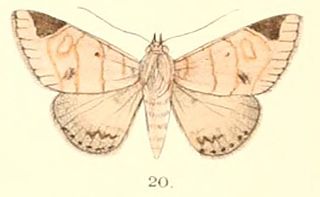
Dordura is a monotypic moth genus of the family Noctuidae erected by Frederic Moore in 1882. Its only species, Dordura aliena, was first described by Francis Walker in 1865. It is found in the Indian subregion, Sri Lanka, Myanmar, Thailand, Peninsular Malaysia, Sumatra, Borneo and New Guinea.

Catocala nymphagoga, the oak yellow underwing, is a moth of the family Erebidae. It is found in Southern Europe, from Bulgaria up to the Iberian Peninsula and sometimes further north as a migrant. It is also found in North Africa and Asia Minor.
Bocchoris rufiflavalis is a moth of the family Crambidae. It can be found in Madagascar.

Ichneutica oliveri is a moth of the family Noctuidae. It is endemic to New Zealand, found only in the South Island. However it has not been observed on the eastern side of that island from mid-Canterbury southwards to Southland. This species is distinctive and is unlikely to be confused with other closely related species. It inhabits tussock grasslands, shrubland as well as granite sand plains, all in the alpine zone. Adults are on the wing from December to March and are attracted to light. They have been observed feeding on the flowers of Hebe species. The life history of this species is unknown as are the larval hosts.
Catephia eurymelas is a species of moth of the family Erebidae. It is found in Kenya.
Catephia poliochroa is a species of moth of the family Erebidae. It is found in Kenya.
Catephia pericyma is a species of moth of the family Erebidae. It is found in Egypt, Kenya, Oman, Saudi Arabia, the United Arab Emirates and Yemen.
Catephia mesonephele is a species of moth of the family Erebidae. It is found in Eritrea, Ethiopia and Kenya.
Samea choristalis is a moth in the family Crambidae. It was described by George Hampson in 1912. It is found in Trinidad.
Sufetula nigrescens is a moth in the family Crambidae. It was described by George Hampson in 1912. It is found in the Democratic Republic of the Congo, Ivory Coast, Madagascar, Nigeria and Sierra Leone.
Sufetula polystrialis is a moth in the family Crambidae. It was described by George Hampson in 1912. It is found on the Louisiade Islands.
Syllepte methyalinalis is a moth in the family Crambidae. It was described by George Hampson in 1912. It is found in Guyana.
Syllepte maculilinealis is a moth in the family Crambidae. It was described by George Hampson in 1918. It is found in Uganda.
Syngamia albiceps is a moth in the family Crambidae. It was described by George Hampson in 1912. It is found in Singapore.
Udea diopsalis is a moth in the family Crambidae. It was described by George Hampson in 1913. It is found in Chile.
Udea ochropera is a moth in the family Crambidae. It was described by George Hampson in 1913. It is found in Colombia and Mexico.
Udeoides nigribasalis is a moth in the family Crambidae. It was described by George Hampson in 1913. It is found in Kenya.
Ulopeza sterictodes is a species of moth in the family Crambidae. It was described by George Hampson in 1912. It is found in Papua New Guinea.
Ambia fulvicolor is a moth in the family Crambidae. It was described by George Hampson in 1917 and it is found in New Guinea.

Ichneutica chlorodonta, also known as the Green-toothed Owlet, is a moth of the family Noctuidae. This species is endemic to New Zealand. It is found throughout the North, South and Stewart Islands and is associated with native forest and shrubland. It can be confused with similar looking species such as I. subcyprea however I. chlorodonta can be distinguished through differences in colouration of its fore and hind wings as well as the length of the male pectinations. The life history of this species is unknown as are the host species of its larvae but adults of I. chlorodonta are on the wing from September to April.



